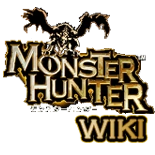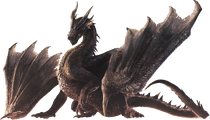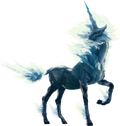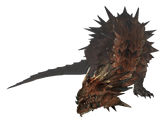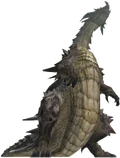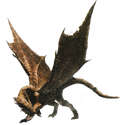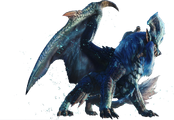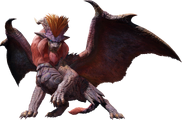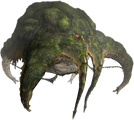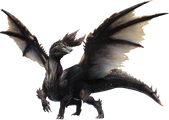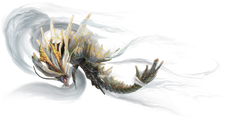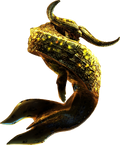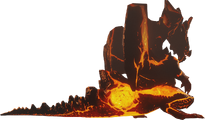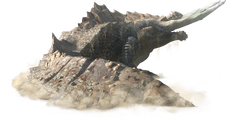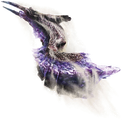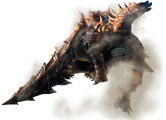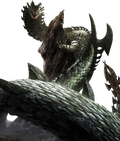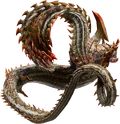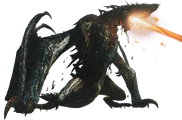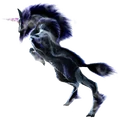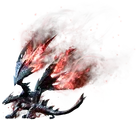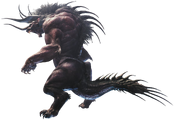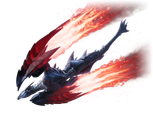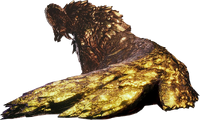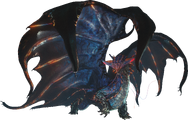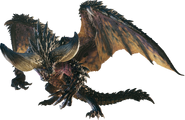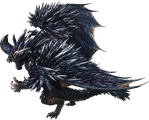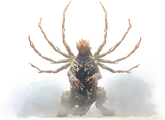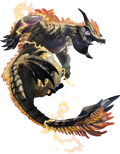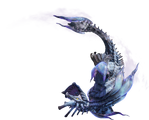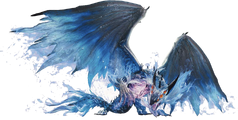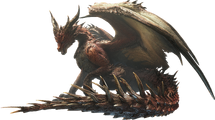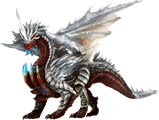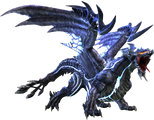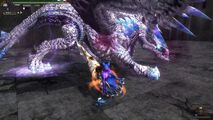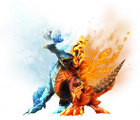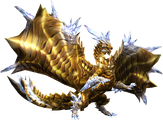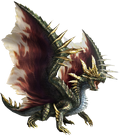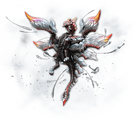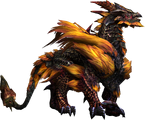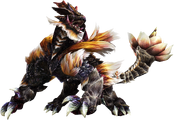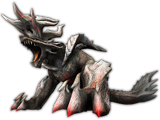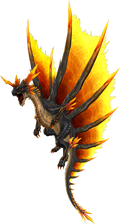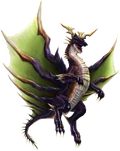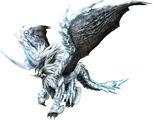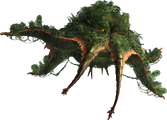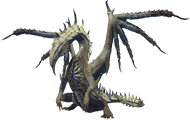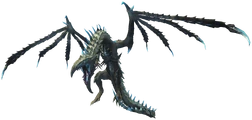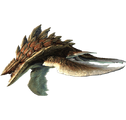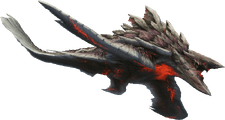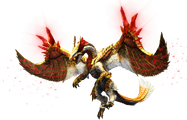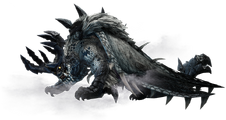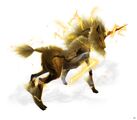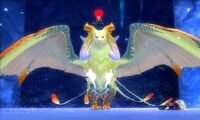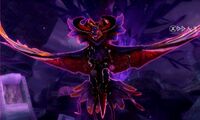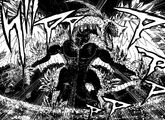Tag: Source edit |
m (→Notes) Tag: Visual edit |
||
| Line 120: | Line 120: | ||
*Despite being classified as an Elder Dragon in external sources,[[Gore Magala]] is classified as a "[[??? (Monster Type)|???]]" Type in all [[Fourth Generation]] games and [[Monster Hunter Frontier Z]], has Wyvern-specific loot (such as Wyvern Tears), and can be captured in traps. |
*Despite being classified as an Elder Dragon in external sources,[[Gore Magala]] is classified as a "[[??? (Monster Type)|???]]" Type in all [[Fourth Generation]] games and [[Monster Hunter Frontier Z]], has Wyvern-specific loot (such as Wyvern Tears), and can be captured in traps. |
||
*In the past, some Elder Dragons were worshiped as gods; however, in the present, the Guild marked them as threats to the ecosystem. |
*In the past, some Elder Dragons were worshiped as gods; however, in the present, the Guild marked them as threats to the ecosystem. |
||
| − | *When an Elder Dragon is present on a standard hunting ground, all small monsters (except [[Neopteron]]s and/or [[Remobra]]s) are absent. |
+ | *When an Elder Dragon is present on a standard hunting ground, all small monsters (except [[Neopteron]]s and/or [[Remobra]]s) are absent. They also cause a certain enviromental characteristics to happen (i.e. [[Teostra]] has the locale have ash, [[Kushala Daora]] makes the locale windy, [[Chameleos]] makes it hazy, etc.) |
**Effluvium-contaminated [[Girros]], [[Raphinos]], [[Jagras]], and [[Mernos]] are exceptions; remaining present on [[Vaal Hazak]] and [[Blackveil Vaal Hazak]] hunts. |
**Effluvium-contaminated [[Girros]], [[Raphinos]], [[Jagras]], and [[Mernos]] are exceptions; remaining present on [[Vaal Hazak]] and [[Blackveil Vaal Hazak]] hunts. |
||
| + | **For [[Monster Hunter World: Iceborne]] master rank expeditions and hunts, one other large monster or elder dragon is present with the main elder dragon there. |
||
| + | **In [[Monster Hunter Rise]], the elder dragons are treated as regular monsters, with no small monsters leaving or environmental characteristics happening. This only applied to the elder dragons that were able to be in normal locales, since [[Wind Serpent Ibushi|Ibushi]] and [[Thunder Serpent Narwa|Narwa]] are fought in Rampage and exclusive arenas. |
||
*Despite not being native to the Monster Hunter universe, [[Behemoth]] is classified as an Elder Dragon in Monster Hunter World. [[finalfantasy:Behemoth|Behemoth]] originally appeared in the Square Enix RPG [[finalfantasy:Final Fantasy II|Final Fantasy II]], and its design is based on the version seen in Final Fantasy XIV. It was brought to Monster Hunter World as a crossover event between Square Enix and Capcom, the creator of the Monster Hunter Series. |
*Despite not being native to the Monster Hunter universe, [[Behemoth]] is classified as an Elder Dragon in Monster Hunter World. [[finalfantasy:Behemoth|Behemoth]] originally appeared in the Square Enix RPG [[finalfantasy:Final Fantasy II|Final Fantasy II]], and its design is based on the version seen in Final Fantasy XIV. It was brought to Monster Hunter World as a crossover event between Square Enix and Capcom, the creator of the Monster Hunter Series. |
||
*While Elder Dragons all count as one classification some Elder Dragons are powerful enough to receive the classification of "[[Dangerous First-Class Monsters]]". This classification refers to the fact that these creatures are not only much rarer than normal Elder Dragons but, it also refers to their innate abilities that defy understanding (even by Monster Hunter logic), being described as capable of bringing the entire world to destruction even. |
*While Elder Dragons all count as one classification some Elder Dragons are powerful enough to receive the classification of "[[Dangerous First-Class Monsters]]". This classification refers to the fact that these creatures are not only much rarer than normal Elder Dragons but, it also refers to their innate abilities that defy understanding (even by Monster Hunter logic), being described as capable of bringing the entire world to destruction even. |
||
Revision as of 18:39, 12 June 2021
Elder Dragons (Japanese: 古龍種 Koryūshu) are a class of monsters introduced in the first generation. Unlike other monster types, which classify monsters by shared traits, Elder Dragons are creatures that defy typical classification and sit outside of the standard ecosystem, regardless of any superficial resemblance to a dragon. These monsters are usually rare creatures with immense power that have lived since ancient times, making them more of a phenomenon than a mere animal; disasters, cataclysms, living forces of nature.[1]
First Generation Elder Dragons
Second Generation Elder Dragons
Third Generation Elder Dragons
Fourth Generation Elder Dragons
Fifth Generation Elder Dragons
Frontier Generation Elder Dragons
Monster Hunter Online Elder Dragons
Monster Hunter Explore Elder Dragons
Monster Hunter Stories Elder Dragons
Monster Hunter Orage Elder Dragons
Notes
- Uniquely, many Elder Dragons can be repelled if they are not slain. In some games, they will retain the damage dealt to them, allowing one specific dragon to be fought over multiple quests.
- Elder Dragons exhibit a wide variety of body types not found in other classes, the most common being a quadrupedal entity with a long tail and a pair of wings. For this reason, Kirin, Yama Tsukami, and Nakarkos were placed in the Elder Dragon category.
- Elder Dragons cannot be captured in traps. They can, however, be put to sleep using a sleep weapon (in some cases), which enables a hunter to perform Sleep Bombing.
- Despite being classified as an Elder Dragon in external sources,Gore Magala is classified as a "???" Type in all Fourth Generation games and Monster Hunter Frontier Z, has Wyvern-specific loot (such as Wyvern Tears), and can be captured in traps.
- In the past, some Elder Dragons were worshiped as gods; however, in the present, the Guild marked them as threats to the ecosystem.
- When an Elder Dragon is present on a standard hunting ground, all small monsters (except Neopterons and/or Remobras) are absent. They also cause a certain enviromental characteristics to happen (i.e. Teostra has the locale have ash, Kushala Daora makes the locale windy, Chameleos makes it hazy, etc.)
- Effluvium-contaminated Girros, Raphinos, Jagras, and Mernos are exceptions; remaining present on Vaal Hazak and Blackveil Vaal Hazak hunts.
- For Monster Hunter World: Iceborne master rank expeditions and hunts, one other large monster or elder dragon is present with the main elder dragon there.
- In Monster Hunter Rise, the elder dragons are treated as regular monsters, with no small monsters leaving or environmental characteristics happening. This only applied to the elder dragons that were able to be in normal locales, since Ibushi and Narwa are fought in Rampage and exclusive arenas.
- Despite not being native to the Monster Hunter universe, Behemoth is classified as an Elder Dragon in Monster Hunter World. Behemoth originally appeared in the Square Enix RPG Final Fantasy II, and its design is based on the version seen in Final Fantasy XIV. It was brought to Monster Hunter World as a crossover event between Square Enix and Capcom, the creator of the Monster Hunter Series.
- While Elder Dragons all count as one classification some Elder Dragons are powerful enough to receive the classification of "Dangerous First-Class Monsters". This classification refers to the fact that these creatures are not only much rarer than normal Elder Dragons but, it also refers to their innate abilities that defy understanding (even by Monster Hunter logic), being described as capable of bringing the entire world to destruction even.
- The only Elder Dragons to obtain this title so far are; Fatalis, Crimson Fatalis, White Fatalis, Alatreon, Disufiroa, Dire Miralis, Merphistophelin, and Elemental Merphistophelin.
References
- ↑ Dialogue from the Chief Ecologist, Monster Hunter: World: "We've taken to using the term Elder Dragon for any creature that defies ordinary classification, but I suppose you could call them a type of phenomenon: disasters, cataclysms, living, breathing forces of nature."
